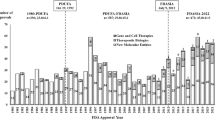Abstract
This is the fifth in a series of triennial reports by the Tufts Center for the Study of Drug Development (CSDD) examining various aspects of recent new drug approvals in the United States. In 1996, 1997, and 1998 the United States Food and Drug Administration (FDA) approved 122 new drugs, 110 of which met Tufts CSDD’s definition of a new chemical entity (NCE). Of the 110, 38 (35%) received priority review, while 72 (65%) had standard review. The mean length of the clinical phase (investigational new drug application [IND] filing to new drug application [NDA] submission) was 70.3 months (ie, 5.9 years), and the approval phase (NDA submission to approval) was 16.8 months (1.4 years). Both the clinical and approval phases represent decreases from those values for the previous three-year period (19% and 31%, respectively). The decrease in the clinical phase for the 1996 to 1998 NCEs represents the first such decline since the mid-1980s. The mean approval phase for priority NCEs (11.8 months) was 38% shorter than that for standard NCEs (19.5 months). Of the 107 NCEs for which foreign marketing data were available, 49% were first approved for marketing in the United States, while 26% were available in foreign markets one or more years prior to United States approval, with a mean of 5.7 years of prior foreign marketing. The percent of products first available in the United States represents a considerable increase over that number for previous years.
Similar content being viewed by others
References
Kaitin, KI, Manocchia, MA. The new drug approvals of 1993, 1994, and 1995: trends in drug development. Am J Therapeutics. 1997 Jan;4(1):46–54.
Kaitin, KI, Manocchia M, Seibring M, Lasagna, L. The new drug approvals of 1990, 1991, and 1992: trends in drug development. J Clin Pharmacol. 1994 Feb;34(2):120–127.
Kaitin, KI, DiCerbo, PA, Lasagna, L. The new drug approvals of 1987, 1988, and 1989: Trends in drug development. J Clin Pharmacol. 1991 Feb; 31(2): 116–122.
Kaitin, KI, Richard, BW, Lasagna, L. Trends in drug development: the 1985-86 new drug approvals. J Clin Pharmacol. 1987 Aug;27(8):542–548.
Prescription Drug User Fee Act of 1992. Public Law 102–571 (1992)ct 29;21 USC 379;106 Stat 4491.
Kaitin, KI. The Prescription Drug User Fee Act of 1992 and the new drug development process. Am J Therapeutics. 1997 May;4(5/6):167–172.
Kaitin, KI. Statement. Hearing before the Subcommittee on Health and Environment of the Committee on Commerce, House of Representatives. The Need for FDA Reform, February 27, 1996. 104th Congress 2d Session:81–7,100–101.
Food and Drug Administration Modernization Act of J997. Public Law 105–115 (1997 Nov 21); 21 U.S.C. 355a; 111 Stat 2296.
Pharma 2005: an industrial revolution in R&D. London: PriceWaterhouseCoopers; 1998.
Final annual performance report: Prescription Drug User Fee Act of 1992: fiscal year 1997 report to Congress. Rockville, MD: Food and Drug Administration; Dec 1997.
FY 1998 performance report to Congress for the Prescription Drug User Fee Act of 1992 as amended by the Food and Drug Administration Modernization Act of 1997. www.fda.gov/ope/pdufa/report98/default.htm#Outcomes.
DiMasi, JA. Improving the new drug development process. Testimony. Hearing before the Subcommittee on Health and Environment of the Committee on Commerce, House of Representatives. Reauthorization of the Prescription Drug User Fee Act and FDA reform, April 23, 1997. 105th Congress 1st Session: 46–52, 62–68. www.house.gov/commerce/health/hearings/042397/witness.htm.
Kessler, DA, Hass, AE, Feiden, KL, Lumpkin M, Temple, R. Approval of new drugs in the United States. Comparison with the United Kingdom, Germany, and Japan. JAMA. 1996 Dec 11;276(22): 1826–1831.
Lurie, P. Falling FDA standards: the Health Research Group study. Med Crossfire. 1999 Apr;1(3):53–55.
Faster approval of new drugs does not compromise US public safety. Tufts Center for the Study of Drug Development Impact Report. June 1999.
Managing the risks from medical product use: creating a risk management framework. Report to the FDA Commissioner from the Task Force on Risk Management. Rockville, MD: Food and Drug Administration; May 1999.
Drews, J. 77ic impact of cost containment on pharmaceutical research and development: 10th CMR annual lecture, June 1995. Carshalton, Surrey, UK: Centre for Medicines Research; 1995.
Author information
Authors and Affiliations
Corresponding author
Additional information
Preliminary results were presented at the 35th DIA Annual Meeting, June 27–July 1, 1999, Baltimore, Maryland, and at the American Society for Clinical Pharmacology and Therapeutics 100th Annual Meeting (poster session), San Antonio, Texas, March 18–20, 1999.
Rights and permissions
About this article
Cite this article
Kaitin, K.I., Healy, E.M. The New Drug Approvals of 1996, 1997, and 1998: Drug Development Trends in the User Fee Era. Ther Innov Regul Sci 34, 1–14 (2000). https://doi.org/10.1177/009286150003400101
Published:
Issue Date:
DOI: https://doi.org/10.1177/009286150003400101




